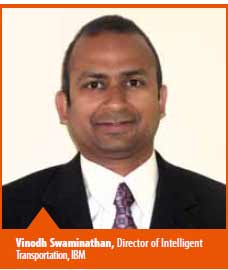In today’s urban landscape, automobiles play an indispensable role in transporting people and goods. They also cause a variety of problems, ranging from traffic accidents, congestion, environmental pollution and massive consumption of fossil fuels. These are a few of the issues which are becoming serious global problems and require fundamental solutions.
Traffic-monitoring solutions are designed to identify congestion, as well as increase safety on the roads. More interactive services include real-time messages through signage for drivers. Determining objectives is the first step toward building an effective monitoring solution. a&s looks at selection criteria, as well as whether IP and HD surveillance is ready for widespread deployment.
In today's urban landscape, automobiles play an indispensable role in transporting people and goods. They also cause a variety of problems, ranging from traffic accidents, congestion, environmental pollution and massive consumption of fossil fuels. These are a few of the issues which are becoming serious global problems and require fundamental solutions.
Traffic-monitoring solutions are designed to identify congestion, as well as increase safety on the roads. More interactive services include real-time messages through signage for drivers. Determining objectives is the first step toward building an effective monitoring solution. a&s looks at selection criteria, as well as whether IP and HD surveillance is ready for widespread deployment.
Resolution is the latest buzz in video surveillance and certainly provides benefits for traffic installations. However, megapixel images require additional bandwidth, storage and processing. Megapixel image sensors are mostly CMOS ones, which need additional illumination that is not always available at night. While the benefits of network cameras will eventually increase adoption, the current status limits where they can be placed.
Traffic-monitoring solutions are handled on a daily basis by operators and enforcement agencies. They demand results that are sometimes in conflict. While reliability and uptime are clear priorities, other nontechnical issues such as training and ease of use are just as important. Balancing different needs against real-world time and budget constraints requires careful planning. Ultimately, traffic-monitoring deployments can help save lives, time and money and sustain the environment.
Traffic has accompanied the rise of urbanization, as more people vie for limited space on roads. While there are more ways for commuters to reach their desired destination, congestion is a constant factor. Beyond being a nuisance, traffic takes a significant toll financially. In Germany alone, traffic congestion cost US$425 million in lost time and fuel in 2010, according to the ADAC, the German equivalent of the AAA. 
Transportation, traffic and congestion in urban areas are a huge cost of doing business. “Almost 1 percent of the GDP for a city or country is the cost of congestion,” said Vinodh Swaminathan, Director of Intelligent Transportation, IBM. “As we talk to transportation CIOs from our annual study, a primary area of focus over the next five years is business intelligence and analytics.” The biggest and fastest growing cities in the world are investing trillions in urban infrastructure, making traffic monitoring a top priority. Cisco Systems estimates the traffic monitoring market will have a CAGR in the low teens to exceed $800 million by 2015, said Dan O'Malley, Senior PM for the Physical Security Business Unit.
 In China, large traffic-monitoring networks are being deployed. While the coastal region is more developed, there remains great potential in western China, said Rui Ma, Director of Intelligent Transportation, Hikvision Digital Technology. In Europe, more cities are concentrated now and regulate traffic more in urban areas or business parks. One way to manage vehicular access is with bollard-restricted urban areas, said Koen Hobbelink, Business Development Manager of the Netherlands for Nedap. The market is clearly growing, particularly for incident management. “The business case for video, if you calculate the cost of a major artery being blocked, makes it very cheap to put in a camera,” said Peter de Konink, Product Line Manager for Codecs and Analytics, Siqura (a TKH Group company). “A delay of an hour has a price, and that's quite high.”
In China, large traffic-monitoring networks are being deployed. While the coastal region is more developed, there remains great potential in western China, said Rui Ma, Director of Intelligent Transportation, Hikvision Digital Technology. In Europe, more cities are concentrated now and regulate traffic more in urban areas or business parks. One way to manage vehicular access is with bollard-restricted urban areas, said Koen Hobbelink, Business Development Manager of the Netherlands for Nedap. The market is clearly growing, particularly for incident management. “The business case for video, if you calculate the cost of a major artery being blocked, makes it very cheap to put in a camera,” said Peter de Konink, Product Line Manager for Codecs and Analytics, Siqura (a TKH Group company). “A delay of an hour has a price, and that's quite high.”
DESIGNING TRAFFIC SOLUTIONS
 There is no sure-fire way to resolve congestion. A surveillance solution for a downtown intersection will have completely different priorities from a highway, said Alf Chang, Senior Consultant for a&s magazines and a former installer. Cameras are getting smarter with analytics, but form just one part of a total monitoring solution. The agency considering a traffic solution must determine why it is needed in the first place; the benefits it hopes to achieve should be narrowed down. “If you don't do this effectively, don't be surprised if the quality is not there when you need to review the stored images,” said Dave Gorshkov, CEO of Digital Grape. He is also Chair of the CCTV and VCA Technical Standards Working Group for the American Public Transportation Association.
There is no sure-fire way to resolve congestion. A surveillance solution for a downtown intersection will have completely different priorities from a highway, said Alf Chang, Senior Consultant for a&s magazines and a former installer. Cameras are getting smarter with analytics, but form just one part of a total monitoring solution. The agency considering a traffic solution must determine why it is needed in the first place; the benefits it hopes to achieve should be narrowed down. “If you don't do this effectively, don't be surprised if the quality is not there when you need to review the stored images,” said Dave Gorshkov, CEO of Digital Grape. He is also Chair of the CCTV and VCA Technical Standards Working Group for the American Public Transportation Association.
Determining objectives early Traffic monitoring is concerned with congestion, but there are other issues technology can address. “Road safety and physical accessibility are other goals,” said Mark Cartwright, Technical Secretary of the Urban Traffic Management and Control, a UK agency. “The challenge traffic managers have is how to meet a range of conflicting policy goals with the traffic management tools at their disposal.”
Understanding and clearly acknowledging what operators want to accomplish plays a huge role. “You don't want to see people putting up cameras, setting up networks and streaming to the back end because they can,” Swaminathan said. “If they understand the outcomes they want to drive and what types of video data are more important, mediumand long-term goals for operating infrastructure would make more sense to the city.”